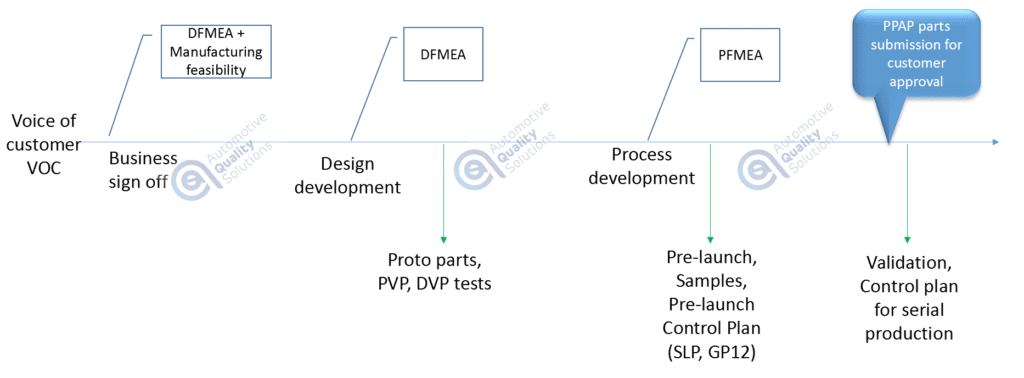During the Start of Production (SoP) phase, each organization takes part in the Production Part Approval Process (PPAP).
It’s one of the stages of product approval, apart from approving the production process and validating the manufactured product, supervised by the engineering department. The main goals of PPAP are:
- Defining actions and responsibilities to ensure the correct application of the part approval process in the pre-launch phase and current production
- Verifying that all customer requirements have been fully understood by the supplier
- Checking that the off-Tool off Process (OTOP) will enable the production of parts compliant with these requirements
- Verifying the passage of tests carried out for confirmation within the prescribed time
- Ensuring the final production process in the final location (OTOP) retains all functional, reliability, dimensional, and aesthetic characteristics

We sometimes say that PPAP summarizes our work as a supplier and culminates in Advanced Product Quality Planning (APQP)
From the IATF point of view, the requirement that includes PPAP we can find in section 8.3.4.4 – Product Approval Process. An important aspect mentioned in this section is the need to complete the approval process of externally supplied components (often referred to as “buy components”) before submitting the final product.
It is recommended that part submission should occur after internal or external verification of the manufacturing process by a customer representative (e.g., SQE, STA).
PPAP Elements
During PPAP, the organization must submit 18 elements to the customer to guarantee that the supplier can meet the appropriate quality and quantity requirements for the manufactured product. These elements are:
During the PPAP, the organization must submit 18 elements to the customer, which guarantee that the supplier is able to meet the appropriate quality and quantity requirements for the manufactured product. All of them are listed below:
- Design Records
- Engineering Change Documents
- Customer Engineering Approval
- Design FMEA
- Process Flow Diagrams
- Process FMEA
- Control Plan
- Measurement System Analysis Studies MSA
- Dimensional Results
- Records of Material / Performance Test Results
- Initial Process Studies
- Qualified Laboratory Documentation
- Appearance Approval Report
- Sample Production Parts
- Master Sample
- Checking Aids
- Customer Specific Requirements
- Part Submission Warrant (PSW)
Depending on the required submission level (from 1 to 5), there are two approaches:
- Submit to the client and keep copies of documents and samples in an appropriate place.
- Keep copies of documents and samples in a suitable place and make them available to the customer upon request.
If the submission level is unknown, please contact the customer—the default level is level 3. The customer must approve it before production, reflecting the maximum quantities for the production ramp-up curve.
Production parts preparation
Parts for approval must be taken from a significant production run, i.e., 1 to 8 hours, and a minimum of 300 consecutive parts, unless otherwise agreed in writing with the customer. Additionally, the production process should be in OTOP (off-tool off-process) status, meaning it should be final and located in a definitive production location.
It is also important to remember that when submitting parts dedicated to PPAP to the client, approval should be obtained for all sub-components included in the manufactured product.
Product Approval Process – What mistakes to avoid?
The Production Part Approval Process (PPAP) is vital for organizations during both new product launches and ongoing production. Understanding common pitfalls is essential to meet compliance requirements within the required timeframe. If you want to know how to navigate PPAP efficiently and avoid mistakes to ensure timely approvals, you’re in luck! You’ll find this information in a separate article on our blog page.
And what about PPAP samples preparation?
We also describe this activity on our blog page.
Dariusz Kowalczyk


